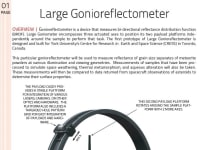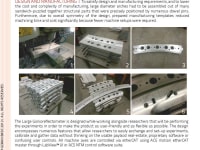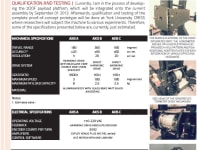Overview
Gonioreflectometer is a device that measures bi-directional reflectance distribution function (BRDF). Large Goniometer encompasses three actuated axes to position its two payload platforms independently around the sample to perform that task. The first prototype of Large Gonioreflectometer is designed and built for York University’s Centre for Research in Earth and Space Science (CRESS) in Toronto, Canada.
This particular gonioreflectometer will be used to measure reflectance of grain size separates of meteorite powders at various illumination and viewing geometries. Measurements of samples that have been processed to simulate space weathering, thermal metamorphism, and aqueous alteration will also be taken. These measurements will then be compared to data returned from spacecraft observations of asteroids to determine their surface properties.
Design and Manufacturing
To satisfy design and manufacturing requirements, and to lower the cost and complexity of manufacturing, large diameter arches had to be assembled out of many sandwich-puzzled together structural parts that were precisely positioned by numerous dowel pins. Furthermore, due to overall symmetry of the design, prepared manufacturing templates reduced machining time and cost significantly because fewer machine setups were required.
The Large Gonioreflectometer is designed while working alongside researchers that will be performing the experiments in order to make the product as user-friendly and as flexible as possible. The design encompasses numerous features that allow researchers to easily exchange and set-up experiments, calibrate and gather data without thinking on the usable payload real-estate, proprietary software or confusing user controls. All machine axes are controlled via etherCAT using ACS motion etherCAT master through LabView™ UI or ACS NTM control software suite.
Marketability
Scalable design allows for easy customization of the gonioreflectometer to any size allowing for multiple product lines. In collaboration with optics equipment and hardware manufacturers additional accessories could be designed for other custom applications thus expanding the business into other markets.
Qualification and Testing
Currently, I am in the process of developing the 2DOF payload platform, which will be integrated onto the current assembly by September 01 2013. Afterwards, qualification and testing of the complete proof-of-concept prototype will be done at York University CRESS where researchers will subject the machine to various experiments.
Please see attached files for more info and images of the prototype system.
Video
Like this entry?
-
About the Entrant
- Name:Goran Basic
- Type of entry:individual
- Software used for this entry:SolidWorks
- Patent status:none








